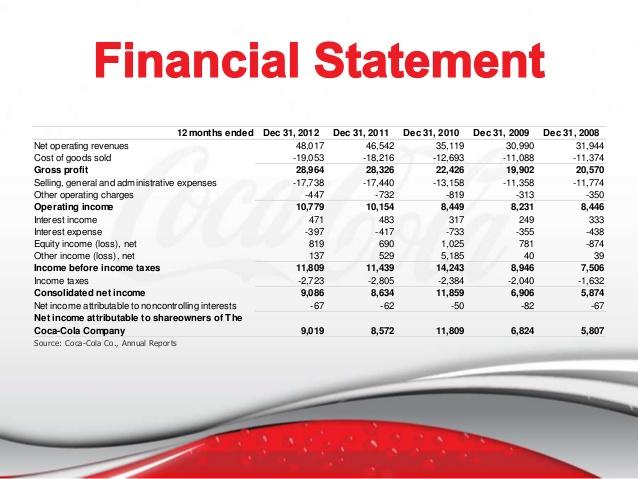Executive Summary
The main objective of this report is to evaluate the competitive position of Coca-Cola. The models used for analysis include the Porter’s Five Forces, PEST analysis, and SWOT. The company experiences moderate pressure from the potential entrants because of the low switching costs. Although there are many substitute products, Coca-Cola’s brand loyalty and decades of services to customers has always put it above others. Individual buyers have low bargaining power.
However, large business organizations have moderate bargaining because of the large quantity they order daily. Because the raw materials used in the manufacturing of soft drinks are readily available, suppliers have low bargaining power. Coca-Cola does not experience threats from rival companies because Pepsi is its only major competitor. The changing political aspects in different countries could cause fluctuation in the distribution and sales of its products.
These include tax and production related policies. The economic aspects that influence the company’s business operations include the gross domestic product, value of domestic currency against dollar, tax and labor policies. In terms of social factors, the increasing health concerns about soft drinks and promotion of health drinks could affect the performance of Coca-Cola. The company has used technology in the packaging design and development of distribution systems to improve customer experiences.
The strengths of Coca-Cola are based on the 2011 Interbrand Award, vast presence, high valuation and brand loyalty. Just like its main rival, Coca-Cola should consider. The product diversification provides greater opportunities to the company. The scarcity of water is posing a significant threat, but in overall, Coca-Cola is still the best in the soft-drinks industry.
Introduction
Coca-Cola is the largest international corporation in the soft-drinks industry. Its closest competitor is Pepsi, which also commands a big portion of the market. The company has a vast brand presence across the world. Its products are found in two hundred countries. Even though the company has had huge success for many decades, the changing business environment in the soft-drinks industry could have negative impacts on its performance.
To evaluate the company’s competitive position in the market, models such as Porter’s Five Forces, PEST Analysis and SWOT are used. Although Coca-Cola is still the best brand, several issues such as scarcity of water, product diversification, and promotion of health drinks could affect its performance.
The Porte’s Five Forces Analysis
Threats of New Entrants
The company experiences moderate pressure from the potential competitors who intend to enter the industry. Since the barriers to entry in the beverage industry are significantly low, the potential firms will incur low switching costs. As a result, there is increased the number of new brands entering the market. To maintain its brand loyalty among customers, Coca-Cola invests significantly in advertisement and product promotion strategies (Butler, 2015). Consequently, it becomes difficult for the new entrants to have significant effects in its existing market segments.
Threats of Substitutes
The threat imposed on the company by the substitute products and services are moderate to high. There are many brands of energy drinks and beverages in the market (Anna, 2016). These brands might serve the same purpose Coca-Cola products do. For instance, it might be difficult for customers to distinguish the difference between Coca-Cola and Pepsi brands. On the other hand, substitute products and services often use pricing as a technique of diverting customers’ attention. However, the unique flavor of the Coca-Cola, its decades of services to the customers and brand loyalty give it the necessary advantages over the substitutes (Butler, 2015).
The Buyers’ Bargaining Power
The company experiences low pressure in terms of its individual customers’ bargaining power. Business organizations that order Coca-Cola products daily have higher bargaining power. Nevertheless, the company lessens the burden of their bargaining power because of the brand loyalty of the end consumers (Dudovskiy 2015).
Suppliers’ Bargaining Power
The main raw materials used in the manufacturing of soft drinks are carbonated water, caffeine, sweetener, and phosphoric acid. Coca-Cola is likely to be the largest customer of the suppliers that are neither differentiated nor concentrated. Therefore, the suppliers in the industry have low bargaining power in terms of pricing. One of the contributing factors is that the raw materials are readily available to all firms at low costs (Butler, 2015).
Rivalry among Competitors
The rivalry among the competitors is very low. Coca-Cola’s main rival in the market is Pepsi. However, the business operations of Pepsi have not interfered with those of Coca-Cola. Although other competitors continue to emerge, the company commands the largest market share (The Coca-Cola Company, 2015).
PEST Analysis
Political Factors
To maintain the status as food products, various governments regulate their manufacturing processes. Companies that fail to meet the established standards face consequences and Coca-Cola is not left out. Changes in tax-related laws and environmental regulations in domestic and foreign markets are challenges that the company must abide by those laws and policies in order to execute its businesses smoothly (Dudovskiy, 2015). Political conditions such as civil conflicts, restrictions, and government policies might interfere with the international markets. Coca-Cola has never experienced political challenges because of its clean track of adhering to local laws and political changes.
Economic Factors
The factors mentioned in this context depend on the level of economic growth in a country, industry, currency exchange rates, tax rates, and labor policies. For instance, the 2007-2009 global financial crises had negative impacts on many local and international organizations (The Coca-Cola Company, 2015). However, Coca-Cola was not affected by the crisis. It maintained an operating margin of approximately 22 percent. The severe devaluation of the Venezuela currency in the year 2014 made Coca-Cola reduce its market share in the country by approximately 55 percent. Such situations might occur in other countries where the company operates (Dudovskiy, 2015).
Social Factors
The majority of people in the United States and other countries have developed an interest in healthy lifestyle. As a result, people discern soft drinks because health advisers consider them junk foods. The proponents of healthy diet recommend bottled water instead of Coca-Cola and other drinks (The Coca-Cola Company, 2015). The urge of leading a healthy lifestyle and increased level of obesity concerns has significantly reduced the consumption of energy drinks (Dudovskiy 2015).
Technological Factors
The efficiency of Coca-Cola’s services is based on the technology platform they use in production, distribution and marketing. The Company has effectively used modern technology to develop cans and plastic bottles as their new packaging. Since they were easy to handle, sales volume of Coca-Cola products significantly increased. The introduction of technology based equipment used in inventory, production, distributions and sales have also increased the volume of production and effectiveness deliveries of its products (The Coca-Cola Company, 2015).
Opportunities and Weaknesses Based on External Analysis
Without threats from new entrants and rivals, Coca-Cola can take the opportunity to penetrate new markets and increase its market share. It can produce bottled water, health drinks, and snacks and use them as an opportunity to counter the threat from substitutes. The company can use its technological strength to launch intensified marketing strategy in potential markets. Coca-Cola does not effectively assess the political and economic conditions of countries where it operates. Instability in those countries could cause a significant decrease in sales and loss of property.
SWOT Analysis
Strengths
Based on the brand equity, Coca-Cola was the award winner of the 2011 Interbrand Award. Together with its brand recognition and the vast presence in the world, Coca-Cola has remained the best producer and distributor of energy drink. In terms of valuation, Coca-Cola is valued at approximately 80 billion dollars. The valuation takes into consideration all business aspects such the production plants across the world, assets, the brand value, costs of operation and revenues.
With such vast financial and resource capability, the company has the power to control the market. Since it operates in two hundred countries, there are high chances of getting Coca-Cola brand and products in every country. Such a vast presence has helped in creating a gigantic brand name and brand loyalty (Anna, 2016).
The company has an effective distributing channel through which it delivers products to its customers in time. Shoppers and retail traders around the world incorporate Coca-Cola products in their stores. The shops and retail traders have been doing the distribution work freely. In addition, the company has distributing trucks they use to supply their customers. The management of the Coca-Cola Company is based on innovation, collaboration, integrity and accountability. Leaders are committed to providing quality services to all customers. Through training, it improves innovative ability of its human resource (The Coca-Cola Company, 2015)
Weaknesses
The competition between Coca-Cola and its arch rival Pepsi poses a significant threat. The competition escalates and none of the two will give up easily (Butler, 2015). The company has a low product diversification compared to Pepsi that has diversified their production to creating and distributing snacks. While Coca-Cola does not feature in that segment, Pepsi uses the diversified products to boost its revenues. The rate at which health promoters criticize soft drinks is worrying and Coca-Cola could be a victim in the future (Anna, 2016).
Opportunities
The increasing awareness about health drinks, foods, and bottled waters have made many people discern energy drinks such as Coca-Cola and Pepsi. Coca-Cola can take advantage of its brand identity and venture into health drinks and bottled water. Apart from increasing its revenues, the company will also counter the negative campaigns about soft drinks such as Coca-Cola, Fanta, and Sprite among others. Another opportunity is in the developing countries. Penetrating developing regions such as South America, Asia, and Africa will increase the company’s market share. Through the Kinley brand, the company could increase its presence in that segment (The Coca-Cola Company, 2015).
Threats
The scarcity of water is the main threat to the company. Because of the industrial activities and deforestation, climate change has caused reduction of water supply in many countries. Apart from other chemicals used in making Coca-Cola drinks, water is the major raw material. In addition, it plays the major role in its industrial effluent system. Its scarcity could cause a serious problem in its production plants (The Coca-Cola Company, 2015). Companies that offer health drinks and foods such as Café Coffee Day, Starbucks and Costa Coffee continue to take part of markets that initially belonged to Coca-Cola. According to Anna (2016), they might be indirect competitors, but their continuous involvement in the industry will have a direct effect in the future.
Recommendation
Although Coca-Cola commands the soft drinks industry, it continues to face several challenges. The scarcity of water is a growing concern because Coca-Cola relies on it as the main raw materials. To control the situation, the company should adopt modern technology to harvest water from large water bodies and rain water. It should also increase its investment in bottled water and health drinks to increase sales. Being a household brand, Coca-Cola can easily penetrate new markets in the developing world.
Conclusion
The strengths of Coca-Cola supersede its weaknesses. On the other hand, it still has several opportunities than threats. As a result, the company can capitalize on its strengths to continue enjoying huge followings. To minimize threats, the company can exploit the above opportunities to increase its market presence and brand loyalty in new markets, especially the developing countries. Coca-Cola Company has been commanding the lead in the soft-drinks industry. The company has been striving to influence customers across the ages. As a result, it has managed to win a huge brand loyalty among billions of its customers.
However, the health concerns in the developed countries have made millions of customers switch to health drinks and bottled water. Consequently, Coca-Cola could lose a big market share. To continue controlling the industry and increasing revenue, the company can consider diversifying its products by venturing into bottled water, health drinks and snacks. However, the company still enjoys huge market share throughout the world. In conclusion, it could continue to be the best brand if it exploits all the available opportunities because people recognize the brand globally.
References
Anna, M. (2016). SWOT analysis of Coca-Cola. Web.
Butler, R. (2015). Analyzing Porter’s 5 forces on Coca-Cola (KO). Web.
Dudovskiy, J. (2015). Coca Cola PESTEL analysis. Web.
The Coca-Cola Company. (2015). 2015 annual report on form 10-K. Web.
Appendices
Appendix I: Decreased consumption of carbonated drinks as customers switch to bottled water and health drinks
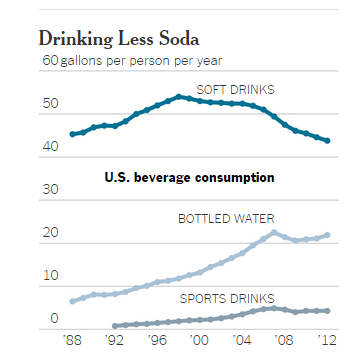
Appendix II: SWOT Analysis of Coca-Cola based on its 2015 Annual Report.
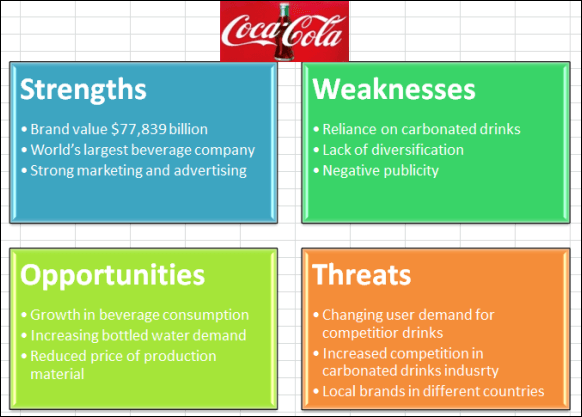
Appendix III: Comparative strategies of Coca-Cola and its close competitor, Pepsi.
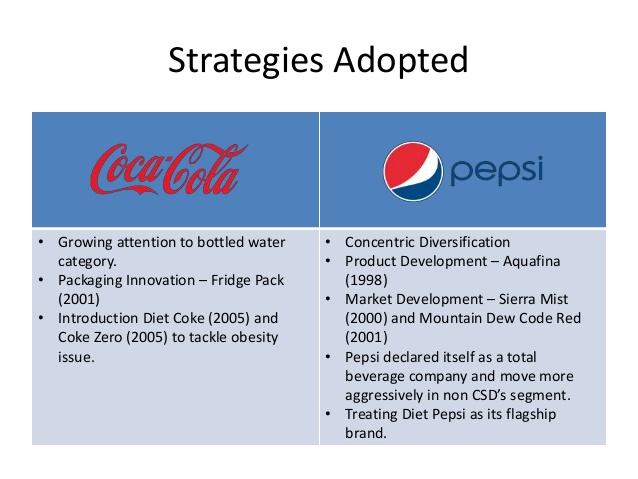
Appendix IV: The Porter’s Five Forces of Coca-Cola based on the 2015 Annual Report
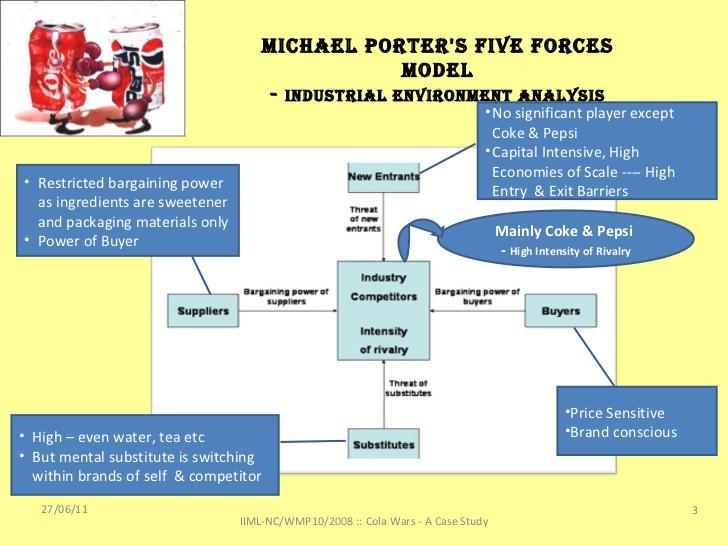
Appendix V: Financial stamen of Coca-Cola
